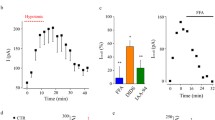Abstract
Although microglial cells are not electrically excitable, they express a large repertoire of ion channels that are activated by voltage, stretch, extracellular ligands, or intracellular pathways (e.g. Ca2+, G-proteins). The patch-clamp technique is the electrophysiological method of choice to study these channels whose expression varies largely in pathological conditions but also during normal development and aging. This chapter focuses on protocols allowing the recording and the analysis of these channels in acute brain slices, with a particular emphasis on the study of channels activated by extracellular ligands.
Access this chapter
Tax calculation will be finalised at checkout
Purchases are for personal use only
Similar content being viewed by others
References
Eder C (2010) Ion channels in monocytes and microglia/brain macrophages: promising therapeutic targets for neurological diseases. J Neuroimmunol 224(1–2):51–55
Kettenmann H, Hanisch UK, Noda M, Verkhratsky A (2011) Physiology of microglia. Physiol Rev 91(2):461–553
Stebbing MJ, Cottee JM, Rana I (2015) The role of ion channels in microglial activation and proliferation—a complex interplay between ligand-gated ion channels, K+ channels, and intracellular Ca2+. Front Immunol. https://doi.org/10.3389/fimmu.2015.00497
Kettenmann H, Hoppe D, Gottmann K, Banati R, Kreutzberg G (1990) Cultured microglial cells have a distinct pattern of membrane channels different from peritoneal macrophages. J Neurosci Res 26(3):278–287
Norenberg W, Gebicke-Haerter PJ, Illes P (1994) Voltage-dependent potassium channels in activated rat microglia. J Physiol 475(1):15–32
Visentin S, Agresti C, Patrizio M, Levi G (1995) Ion channels in rat microglia and their different sensitivity to lipopolysaccharide and interferon-γ. J Neurosci Res. https://doi.org/10.1002/jnr.490420402
Pyo H, Chung S, Jou I, Gwag B, Joe EH (1997) Expression and function of outward K+ channels induced by lipopolysaccharide in microglia. Mol Cells
Boucsein C, Kettenmann H, Nolte C (2000) Electrophysiological properties of microglial cells in normal and pathologic rat brain slices. Eur J Neurosci 12(6):2049–2058
Arnoux I et al (2013) Adaptive phenotype of microglial cells during the normal postnatal development of the somatosensory “Barrel” cortex. Glia 61(10):1582–1594
Schilling T et al (2000) Upregulation of Kv1.3 K(+) channels in microglia deactivated by TGF-beta. Am J Physiol Cell Physiol 279(4):C1123–C1134
Schilling T, Eder C (2015) Microglial K+channel expression in young adult and aged mice. Glia. https://doi.org/10.1002/glia.22776
Rassendren F, Audinat E (2016) Purinergic signaling in epilepsy. J Neurosci Res 94(9). https://doi.org/10.1002/jnr.23770
Haque ME, Kim I-S, Jakaria M, Akther M, Choi D-K (2018) Importance of GPCR-mediated microglial activation in Alzheimer’s disease. Front Cell Neurosci 12:258
Schilling T, Eder C (2013) Patch clamp protocols to study ion channel activity in microglia. Methods Mol Biol 1041:163–182
Avignone E, Ulmann L, Levavasseur F, Rassendren F, Audinat E (2008) Status epilepticus induces a particular microglial activation state characterized by enhanced purinergic signaling. J Neurosci 28(37):9133–9144
Jung S et al (2000) Analysis of fractalkine receptor CX(3)CR1 function by targeted deletion and green fluorescent protein reporter gene insertion. Mol Cell Biol 20(11):4106–4114
Wolf Y, Yona S, Kim KW, Jung S (2013) Microglia, seen from the CX3CR1 angle. Front Cell Neurosci 7:26
Arnoux I, Audinat E (2015) Fractalkine signaling and microglia functions in the developing brain. Neural Plast 80(1):43–56
Hirasawa T et al (2005) Visualization of microglia in living tissues using Iba1-EGFP transgenic mice. J Neurosci Res. https://doi.org/10.1002/jnr.20480
Sasmono RT, Williams E (2012) Generation and characterization of MacGreen mice, the Cfs1r-EGFP transgenic mice. Methods Mol Biol. https://doi.org/10.1007/978-1-61779-527-5_11
Ting JT et al (2018) Preparation of acute brain slices using an optimized N-methyl-D-glucamine protective recovery method. J Vis Exp. https://doi.org/10.3791/53825
Morin-Brureau M et al (2018) Microglial phenotypes in the human epileptic temporal lobe. Brain 141(12):3343–3360
Madry C et al (2018) Effects of the ecto-ATPase apyrase on microglial ramification and surveillance reflect cell depolarization, not ATP depletion. Proc Natl Acad Sci. https://doi.org/10.1073/pnas.1715354115
Schwendele B, Brawek B, Hermes M, Garaschuk O (2012) High-resolution in vivo imaging of microglia using a versatile nongenetically encoded marker. Eur J Immunol. https://doi.org/10.1002/eji.201242436
Davalos D et al (2005) ATP mediates rapid microglial response to local brain injury in vivo. Nat Neurosci 8(6):752–758
Farber K, Kettenmann H (2006) Purinergic signaling and microglia. Pflugers Arch 452(5):615–621
Tsuda M, Inoue K (2016) Neuron-microglia interaction by purinergic signaling in neuropathic pain following neurodegeneration. Neuropharmacology. https://doi.org/10.1016/j.neuropharm.2015.08.042
Lutz C et al (2008) Holographic photolysis of caged neurotransmitters. Nat Methods 5(9):821–827
Rogers JT et al (2011) CX3CR1 deficiency leads to impairment of hippocampal cognitive function and synaptic plasticity. J Neurosci 31(45):16241–16250
Maggi L et al (2011) CX(3)CR1 deficiency alters hippocampal-dependent plasticity phenomena blunting the effects of enriched environment. Front Cell Neurosci 5:22
Milior G et al (2016) Fractalkine receptor deficiency impairs microglial and neuronal responsiveness to chronic stress. Brain Behav Immun 998:149–157. https://doi.org/10.1016/j.bbi.2015.07.024
Linley JE (2013) Perforated whole-cell patch-clamp recording. Methods Mol Biol 998:149–157
Acknowledgments
Work in Audinat lab is funded by grants from the Fondation pour la Recherche Médicale (FRM: DEQ20140329488) and the European Union (ERA-NET Neuron BrIE; H2020-MSCA-ITN EU-gliaPhD 722053).
Author information
Authors and Affiliations
Corresponding author
Editor information
Editors and Affiliations
Rights and permissions
Copyright information
© 2019 Springer Science+Business Media, LLC, part of Springer Nature
About this protocol
Cite this protocol
Avignone, E., Milior, G., Arnoux, I., Audinat, E. (2019). Electrophysiological Investigation of Microglia. In: Garaschuk, O., Verkhratsky, A. (eds) Microglia. Methods in Molecular Biology, vol 2034. Humana, New York, NY. https://doi.org/10.1007/978-1-4939-9658-2_9
Download citation
DOI: https://doi.org/10.1007/978-1-4939-9658-2_9
Published:
Publisher Name: Humana, New York, NY
Print ISBN: 978-1-4939-9657-5
Online ISBN: 978-1-4939-9658-2
eBook Packages: Springer Protocols




